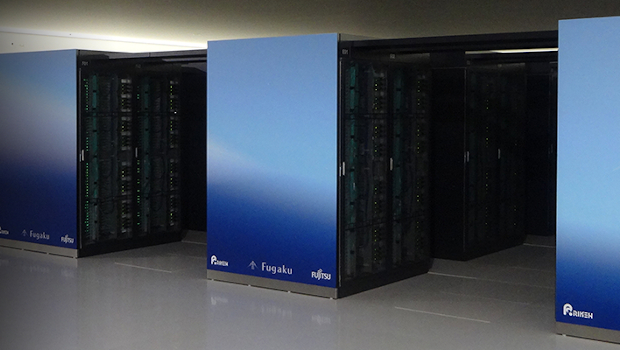
Fugaku retains mantle of world’s fastest supercomputer
The latest semiannual Top500 list of the world’s fastest supercomputers is topped by Fugaku, the same machine that won in June. Built by Fujitsu, Fugaku (pictured) is three times as fast as its nearest rival.
Top500 says that competition for its list seems to be lessening, with the full list of 500 systems having the fewest number of new entries since the organization started its tracking. The list is updated every June and November and has tracked the development of supercomputer performance and architecture since 1993. Nevertheless, two brand new systems managed to break into the top 10 list on their first try.
The new top 10 list also includes two supercomputers that are installed in commercial settings rather than research environments.
The slowest system on the list of 500 scored 1.32PFLOP/sec on the High Performance Linpack (HPL) benchmark, up from 1.23PFLOP/sec recorded in the June 2020 rankings. The HPL benchmark measures how well systems solve a dense system of linear equations.
In a similar vein, the aggregate performance of all 500 systems grew from 2.22 exaflops in June to 2.43 exaflops on the latest list.
Top500’s 10 fastest supercomputers
The fastest and still champion is Fugaku, whose top speed bumped up to 442PFLOP, which is 26PFLOP faster than in June and three times faster than the Number 2 system That’s thanks to increasing its capacity from 7,299,072 cores to 7,630,848 of Arm A64FX processors. The computer was built by Fujitsu and resides at the RIKEN Center for Computational Science (R-CCS) in Kobe, Japan.
At Number 2 is Summit, built by IBM for the Oak Ridge National Laboratory (ORNL) in Tennessee with a performance of 148.8PFLOP/sec. The system has 4,356 nodes, each with two 22-core Power9 CPUs and six NVIDIA Tesla V100 GPUs for a total of 2,414,592 cores. It ranked Number 2 in June as well.
Sierra retained its Number 3 ranking with an HPL score of 94.6 petaflops. Its architecture is similar to that of Number 2, Summit. Sierra has 4,320 nodes (1,572,480 cores) equipped with two Power9 CPUs and four NVIDIA Tesla V100 GPUs.
The Number 4 slot goes to Sunway TaihuLight. It’s powered by Sunway SW26010 processors with 10,649,600 cores and can hit an HPL score of 93PFLOP/sec. The system was built by China’s National Research Center of Parallel Computer Engineering & Technology (NRCPC) and is installed at the National Supercomputing Center in Wuxi, China. It ranked Number 5 in June.
At Number 5 is Selene, an Nvidia DGX A100 SuperPOD based on AMD EPYC processors with Nvidia’s new A100 GPUs for acceleration, boosting its performance from 27.5PFLOP/sec to 63.4PFLOP/sec on HPL. That moved its ranking up from Number 7. It is installed at Nvidia Corp. in the U.S. and has 555,520 cores.
Tianhe-2A (Milky Way-2A), is ranked Number 6 with a performance of 61.4PFLOP/sec on HPL. It’s powered by Intel Xeon CPUs and NUDT’s Matrix-2000 DSP accelerators and has 4,981,760 cores. Milky Way-2A was developed by China’s National University of Defense Technology (NUDT) and is deployed at the National Supercomputer Center in Guangzho, China. It ranked Number 5 in June.
JUWELS Booster Module makes its debut on the list at Number 7. The Atos-built BullSequana machine uses AMD EPYC processors with Nvidia A100 GPUs for acceleration, which is similar to Selene. Installed at the Forschungszentrum Jülich in Germany, it has 449,280 cores and an HPL score of 44.1PFLOP/sec, making it the fastest in Europe. It is part of a modular system, and a second Xeon-based JUWELS Module is listed separately on the TOP500 at position 44. The modules are integrated by the ParTec Modulo Cluster Software Suite.
Filling the Number 8 slot is HPC5, a Dell PowerEdge system with a performance of 35.5PFLOP/sec powered by Intel Xeon Gold CPUs and Nvidia Tesla V100 GPUs with a total of 669,760 cores. It is the most powerful system on the TOP500 list that is installed at a customer site and used for commercial purposes. The Italian company Eni S.p.A. installed it. The system ranked Number 6 in June.
Frontera, a Dell C6420 system that was installed last year at the Texas Advanced Computing Center of the University of Texas, is listed at Number 9, down from Number 8. With its 448,448 Intel Platinum Xeon cores, it hits 23.5PFLOP/sec on HPL.
The Number 10 entry, like Number 7, is a new system called Dammam-7, which is installed at Saudi Aramco in Saudi Arabia. The HPE Cray CS-Storm system is built on Intel Gold Xeon CPUs and NVIDIA Tesla V100 GPUs. With 672,520 cores, it reached 22.4PFLOP/sec on the HPL benchmark.
TechCentral Reporters
Professional Development for IT professionals
The mission of the Irish Computer Society is to advance, promote and represent the interests of ICT professionals in Ireland. Membership of the ICS typically reduces courses by 20%. Find out more







Subscribers 0
Fans 0
Followers 0
Followers